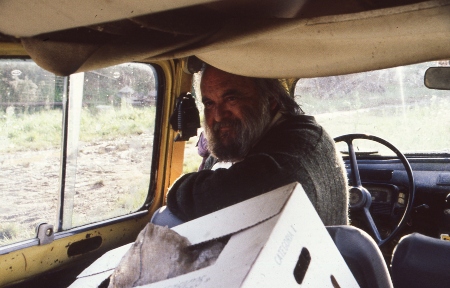Joaquim Jordà
“Em pregunteu pel meu descobriment del cinema. Doncs, naturalment, fou a Santa Coloma. Allí hi havia dos cinemes: el ‘del Cèrcol’ i el ‘Parroquial’. El primer era el de programació comercial. Jo, mentre vaig viure a Santa Coloma, fins als deu anys, anava al Cinema Parroquial. Pel que jo recordo aquest tan sols tenia tres pel·lícules, una de Tom Mix, una altra que si no m’equivoco es deia Pedro el Grande (...) i la famosa Nosferatu... Nosferatu és la que més m’impressionava. La vaig arribar a veure desenes de vegades, me la coneixia de memòria, sabia i esperava els seus moments més terrorífics: mig m’amagava darrera de les mans amb els dits entreoberts mirant de tant en tant”.
(Joaquim Jordà en "Joaquín Jordá", J.M. García Ferrer y Martí Rom, 2001)
Joaquim Jordà was born on August 9 of 1935, son of a notary from Santa Coloma de Farners (Girona). He grew up with a great fondness for cinema and dreamt of becoming a writer. Nonetheless, due to his parent’s desires, Jordà studied Law in Barcelona, but soon after had his first professional encounter with the world of film: during a Christmas vacation with his family, Joan Lladó approached him while he was writing, and asked him to write a script for him. With the money he earned from that job, Jordà made his first trip to Paris, where he became a dedicated visitor of the Cinémathèque.
When he managed to finish his career in Law, Jordà moved to Madrid in order to enter the Institute of Cinematographic Research and Experiences (Instituto de Investigaciones y Experiencias Cinematográficas), soon after renamed Official School of Cinematography (Escuela Oficial de Cinematografía). Because of a quarrel with Carlos Saura, professor of the centre, Jordà abandoned the school, though he didn’t let go of his relationship with cinema. In 1961, Jordà directed his first short film, Día de los muertos, and then returned to Barcelona, where he directed, along with Jacinto Esteva, his first full-length film, Dante no es únicamente severo (1967), which was and is considered a manifesto of the School of Barcelona (Escola de Barcelona), a movement that wished to overcome the censorship barriers imposed by Francoist Spain through formal experimentation.
Towards the end of the sixties, the exhaustion of life under said regime drove him to exile in Italy, where he had close contact with groups such as Lotta Continua and Autonomia Operaria, and directed militant films such as Portogallo, paese tranquilo (1969), Lenin Vivo (1970), assigned by the Italian Communist Party, and Spezziamo le catene (1971), with Ivo Barnabó Micheli, centred on the absenteeism and sabotage practices to Alfa Romeo.
The year 1973 saw his return to Barcelona, where he participated, along with philosopher Santiago López Petit, in the development of the movement for labour autonomy (Autonomía Obrera). From that year onwards, he also began his career in translation, especially with Jorge Herralde’s editorial company, Anagrama, where he also directed the collection Cuadernos de Cine. With knowledge of French, Catalan, Italian and Portuguese, he was in charge of translating Breton, Stendhal, Baudrillard and more. In spite of the intensity of his translator tasks, this was no obstacle for his film career: a few years after starting with this role, he filmed one of his key documentaries, Numax presenta... (1980), in which the worker’s assembly of the electrical household appliances Numax told its experience with the self-management and closing of the company.
After Numax, Jordà returned to Madrid and began his phase as a screenwriter, collaborating with filmmakers such as Mario Camús or Vicente Aranda. His re-entry into direction came 10 years after, with El encargo del cazador (1990) and Un cos al bosc (1996), the last of which was his second fiction full-length feature. This time later saw the beginning of his development as a professor, through a screenwriting course in the Pompeu Fabra University, where he taught the processes and systems involved in constructing audiovisual stories.
In 1997, due to a stroke, Jordà developed agnosia and alexia, two afflictions that compromised his capacity to distinguish shapes and colours, as well as understanding the written word and orienting himself in space and time. Even if this condition prevented him from working in fiction projects, it also intensified his documentary career: soon after the stroke, Jordi Balló, director of the Master in Creative Documentary and now dean of Communication at the UPF, suggested working with Núria Villazán Martín in the shooting of Mones com la Becky, a reflection on psychiatric pathologies.
De nens (2003), about the “Raval case”, Vint anys no és res (2004), which recovers the protagonists of Numax presenta..., and Més enllà del mirall (2006), where Jordà researches his own afflictions, consolidated this prolific period, that concluded in 2006 with the death of the director due to a pancreatic and liver cancer before the shooting of Morir de dia, which was scheduled to be his last film.
“Quan tenia 17 anys vaig escriure alguna cosa. Vaig acabar un llibre de contes i el vaig presentar a un concurs. Vaig quedar segon, el primer el va guanyar Mario Vargas Llosa. Em vaig ofendre tant que vaig decidir no escriure mai més. Tenia pensada una novel·la molt complexa que havia de tenir 40 o 50 volums, però vaig caure en el vici del robbe-grilletisme, el que es deia ‘tècnica objectiva de narració’ (...). Al final em vaig avorrir tant que vaig decidir que el cinema era molt més ràpid i em vaig passar al cinema”
(Joaquim Jordà entrevistat per María Ángeles Cabré i Dolors Udina el 2003, Vasos Comunicantes Nº 26)

